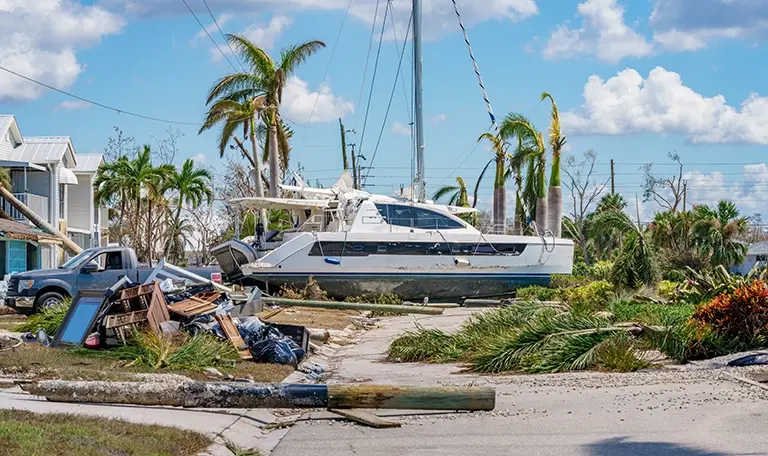Hurricanes are powerful natural phenomena that can cause devastating damage to homes, buildings, infrastructure, and communities. Understanding the different categories of hurricanes and the types of damage they can cause is essential for homeowners to prepare, protect, and mitigate risks effectively. In this blog post, we’ll explore the various categories of hurricanes and the types of damage to expect from each category, providing valuable insights for homeowners to safeguard their properties and loved ones.
1. Category 1 Hurricane
Category 1 hurricanes are characterized by wind speeds ranging from 74 to 95 miles per hour (mph) on the Saffir-Simpson Hurricane Wind Scale. While Category 1 hurricanes are considered relatively weak compared to higher categories, they can still cause significant damage, including:
– Damage to trees, power lines, and unanchored mobile homes
– Minor roof damage, such as shingles blown off
– Some coastal flooding and beach erosion
– Potential power outages and disruptions to utilities
While the damage from a Category 1 hurricane may be less severe compared to stronger storms, it’s essential for homeowners to take precautions and secure their properties to minimize potential risks and hazards.
2. Category 2 Hurricane
Category 2 hurricanes have wind speeds ranging from 96 to 110 mph and pose a greater threat of damage to homes and infrastructure. The types of damage to expect from a Category 2 hurricane include:
– Extensive roof damage, including partial roof failure and significant shingle loss
– Damage to windows, doors, and garage doors, with the potential for broken glass and structural compromise
– Flooding in low-lying areas, particularly along the coast and near rivers and streams
– Downed trees and power lines, leading to widespread power outages and disruptions to utilities
Homeowners in the path of a Category 2 hurricane should take proactive measures to secure their properties, such as installing hurricane shutters, reinforcing windows and doors, and trimming trees and shrubs to reduce the risk of damage.
3. Category 3 Hurricane
Category 3 hurricanes are considered major hurricanes, with wind speeds ranging from 111 to 129 mph. These storms are capable of causing extensive damage and destruction, including:
– Severe roof damage, with the potential for roof failure and structural collapse
– Widespread damage to windows, doors, and exterior walls, resulting in significant water intrusion and structural compromise
– Dangerous storm surge, leading to coastal inundation and flooding of low-lying areas
– Catastrophic damage to mobile homes, buildings, and infrastructure, particularly in coastal communities
Category 3 hurricanes pose a significant threat to life and property, and homeowners should follow evacuation orders and seek shelter in safe, sturdy structures to protect themselves from the storm’s impact.
4. Category 4 Hurricane
Category 4 hurricanes are characterized by wind speeds ranging from 130 to 156 mph and are considered extremely dangerous and destructive. The types of damage to expect from a Category 4 hurricane include:
– Severe and widespread roof and structural damage, with the potential for complete roof failure and collapse of walls and buildings
– Catastrophic damage to windows, doors, and garage doors, with the potential for total destruction of exterior openings
– Devastating storm surge, leading to extensive coastal inundation and flooding of coastal communities
– Widespread power outages, infrastructure damage, and disruptions to essential services
Category 4 hurricanes pose an imminent threat to life and property, and homeowners should evacuate to safe locations well in advance of the storm’s arrival to ensure their safety and well-being.
5. Category 5 Hurricane
Category 5 hurricanes are the most powerful and destructive storms, with wind speeds exceeding 157 mph. These storms can cause catastrophic damage and devastation, including:
– Total destruction of homes, buildings, and infrastructure, with widespread roof and structural failure
– Complete loss of windows, doors, and exterior walls, leaving properties vulnerable to extreme wind and water damage
– Unsurvivable storm surge, leading to extensive coastal inundation and flooding of entire communities
– Severe erosion of coastlines, islands, and barrier islands, altering the landscape and geography of affected areas
Category 5 hurricanes pose an existential threat to life and property, and homeowners in their path should heed evacuation orders and take immediate action to protect themselves and their families from the storm’s fury.
Hurricanes can cause significant damage and destruction, ranging from minor impacts to catastrophic devastation, depending on their category and intensity. Understanding the types of damage to expect from each hurricane category is essential for homeowners to prepare, plan, and protect their properties effectively. By taking proactive measures, securing their homes, and following evacuation orders when necessary, homeowners can minimize risks and ensure their safety and well-being during hurricane season and beyond. At Pixel Homes, we’re committed to helping homeowners in Miami navigate the challenges of hurricane preparedness and recovery, providing valuable resources, insights, and support to protect their homes and families from the impacts of severe weather.
